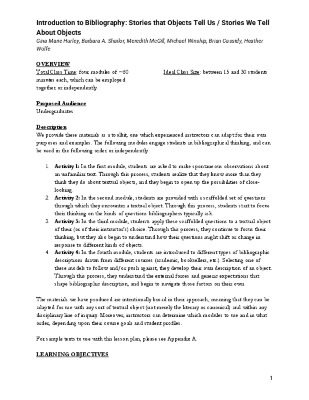Lesson Plan: Introduction to Bibliography
LEARNING OBJECTIVES
1. The materials and physical condition of text objects can be “read” to understand the production processes and historical/cultural factors that created them.
2. Understand the anatomy of a book, or text object, and the importance for material traces for understanding the significance of a book in terms of technology, culture, art, &c.
3. Habits of close looking and description are fundamental practices for learning from text objects and developing research questions.
4. Bibliography depends on the kinds of questions asked of a book, and the kinds of questions asked depend on bibliographic experience/training, professional setting, audience, and personal background.
5. There are many bibliographic practices, each situated in its own traditions and priorities
1. The materials and physical condition of text objects can be “read” to understand the production processes and historical/cultural factors that created them.
2. Understand the anatomy of a book, or text object, and the importance for material traces for understanding the significance of a book in terms of technology, culture, art, &c.
3. Habits of close looking and description are fundamental practices for learning from text objects and developing research questions.
4. Bibliography depends on the kinds of questions asked of a book, and the kinds of questions asked depend on bibliographic experience/training, professional setting, audience, and personal background.
5. There are many bibliographic practices, each situated in its own traditions and priorities
Scott Ellwood (created by)
Jonathan Hill (created by)
Megumi Hill (created by)
Karla Neilsen (created by)
Aaron Pratt (created by)
Jonathan Hill (created by)
Megumi Hill (created by)
Karla Neilsen (created by)
Aaron Pratt (created by)
text/pdf
Introduction to Bibliography: Stories that Objects Tell Us/Stories We Tell About Objects
Gina Marie Hurley, Barbara Shailor, Meredith McGill, Michael Winship, Brian Cassidy, Heather Wolfe, Bibliographical Society of America

